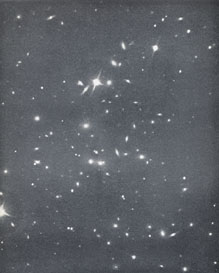


The Observable Region as a Sample of the Universe
The homogeneity indicated by the reconnaissance, even as a rough approximation, is very significant. The uniform distribution extends out to the limits of our telescopes. There is no trace of a physical boundary, no evidence of a super-system of nebulae isolated in a larger world. As far as the observations can be interpreted, the realm of the nebulae may be the universe itself, and the observable region may be a fair sample.
This proposition could not be formulated before the reconnaissance was completed. As long as our positive information was restricted to the stellar system alone, the observable region then available could not possibly be regarded as a fair sample. The stellar system was known to be finite and isolated. Beyond the boundaries lay the universe, unknown, but necessarily different from the star-strewn space within the stellar system. But now we have explored a certain portion of that outer space. Our observable region has been suddenly enlarged a million million fold. It is populated with nebulae, uniformly distributed out to the very limits. If the nebulae do form a super-system, it must be so immense that our sample is wholly insignificant. As far as the reconnaissance is concerned, the notion of a super-system is mere speculation, and, as such, is unnecessary and uneconomical. Let us, then, follow the principle of tie uniformity of nature and accept the observable region as a fair sample of the universe. The assumption will serve as a reasonable working hypothesis until it leads to contradictions. Then it can be revised or replaced to conform with our new information.
The picture suggested by the reconnaissance is a sphere, centred on the observer, about 1,000 million light-years in diameter, throughout which are scattered about 100 million nebulae. The nebulae average about 85 million times as bright as the sun, their over-all diameters average between 15,000 and 20,000 light-years, and the average separation between neighbours is about 2 million light-years. A suitable model would be furnished by tennis balls, 50 feet apart, scattered through a sphere 5 miles in diameter.
We know further that the average mass of the nebulae is about 1,000 million times the mass of the sun, and, consequently, we can assign a numerical value to the smoothed-out density of nebular material in space. The value, between 10-29 and 10-30 grammes per cubic centimetre, is evidently a lower limit to the mean density in the observable region because it ignores matter that may lie between the nebulae. The fact that we have not been able to detect any matter in inter-nebular space does not necessarily exclude its existence, even in considerable quantity, but it does suggest that the minimum density, derived from the nebulae alone, is probably not far below the true value.
The important features of the observable region, considered as a sample of the universe, are: first, the approximate homogeneity; secondly, the general order of the mean density; and, thirdly, an additional characteristic that has not yet been described. The third feature, which will be discussed at length in the next lecture, is the law of red-shifts - the observed fact that light from a distant nebula loses energy in proportion to the distance it travels from the nebula to the observer.
The uniform distribution of nebulae and the linear law of red-shifts suggest that our sample of the universe is too small to indicate its nature. When we consider regions beyond the limits of our telescopes, we can only extend these simple features, on and on, indefinitely. The inferences we can draw are negative at best. Positive information concerning the universe can be derived only from systematic variations whose trends are established within the sample. None was found in the preliminary reconnaissance. Perhaps larger telescopes would reveal them, but larger telescopes are not yet available.
 |
PLATE IV. THE CORONA BOREALIS CLUSTER
The Corona Borealis cluster is almost a replica of the Coma cluster,
but, being nearly three times as remote, appears smaller and
fainter. The fifth nebula appears about
20,000 times fainter than the faintest naked-eye star, and indicates a
distance of about 130 million light-years. The red-shift is
d |
There is, however, another way in which possible variations may be sought. The preliminary results were approximations. The distribution of nebulae was found to be uniform, and the law of red-shifts was found to be linear, within the uncertainties of the investigation, but the uncertainties were considerable. Greater precision might reveal systematic departures from uniformity, and from linearity, even within the observable region as defined with existing instruments. The deviations, if they exist, will evidently be small quantities, and will emerge only from extensive and very accurate data, ranging out to the greatest possible distance. The problem is of first importance, and the answer must be sought with the largest telescopes in operation. A considerable body of the necessary data has now been collected with the Mount Wilson reflectors, and the results will be presented in the lectures which follow.
To anticipate, the investigations lead to alternative pictures, depending upon the alternative possible interpretations of red-shifts. If red-shifts are the familiar velocity-shifts, systematic variations do exist in the observable region, and they suggest an expanding universe that is finite, small, and young. On the other hand, if red-shifts are evidence of some unknown principle of nature, which does not involve actual motion, then variations are not appreciable in our sample, and the observable region is an insignificant fraction of the universe as a whole. Thus, in a certain sense, we again face a choice between a small finite universe and a universe indefinitely large plus a new principle of nature.